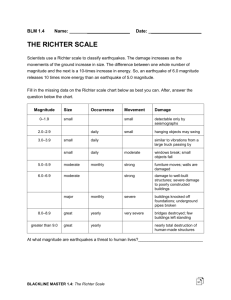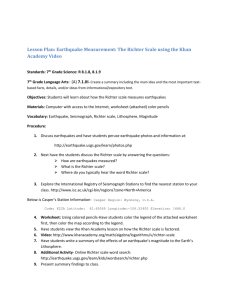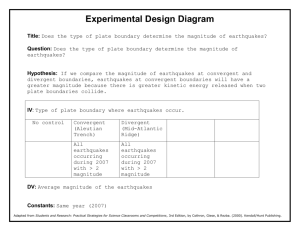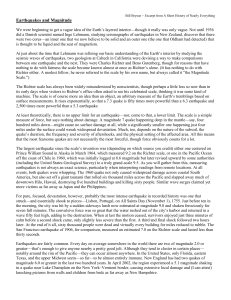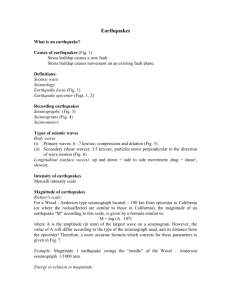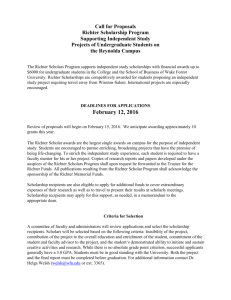What is the Richter Scale?
advertisement
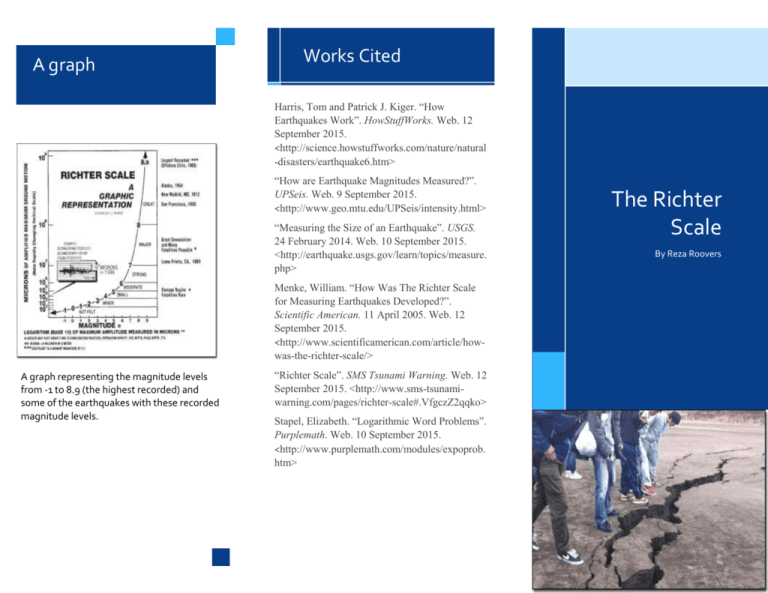
A graph Works Cited Harris, Tom and Patrick J. Kiger. “How Earthquakes Work”. HowStuffWorks. Web. 12 September 2015. <http://science.howstuffworks.com/nature/natural -disasters/earthquake6.htm> “How are Earthquake Magnitudes Measured?”. UPSeis. Web. 9 September 2015. <http://www.geo.mtu.edu/UPSeis/intensity.html> “Measuring the Size of an Earthquake”. USGS. 24 February 2014. Web. 10 September 2015. <http://earthquake.usgs.gov/learn/topics/measure. php> Menke, William. “How Was The Richter Scale for Measuring Earthquakes Developed?”. Scientific American. 11 April 2005. Web. 12 September 2015. <http://www.scientificamerican.com/article/howwas-the-richter-scale/> A graph representing the magnitude levels from -1 to 8.9 (the highest recorded) and some of the earthquakes with these recorded magnitude levels. “Richter Scale”. SMS Tsunami Warning. Web. 12 September 2015. <http://www.sms-tsunamiwarning.com/pages/richter-scale#.VfgczZ2qqko> Stapel, Elizabeth. “Logarithmic Word Problems”. Purplemath. Web. 10 September 2015. <http://www.purplemath.com/modules/expoprob. htm> The Richter Scale By Reza Roovers What is the Richter Scale? The Richter Scale is a standard of measurement used to calculate the magnitude, or the amount of energy released, of earthquakes. The Richter Scale uses the information obtained from the seismograph that records the force and duration of Earthquakes. The Richter Scale rates the magnitude of an earthquake. Earthquakes recorded below level 2 .0 are micro quakes that are not really felt, while the highest was no higher than 9, which was very big and caused a lot of destruction. The Richter Scale was invented by Charles F. Richter from the California Institute of Technology in 1935 as a mathematical tool to compare the size of earthquakes. He wanted to find a simpler way to compare earthquakes as there were big and small earthquakes. By using the information from the seismograph, he was able to calculate and simplify by representing it with a simple digit number for the magnitude. Calculations The way the Richter Scale calculates the magnitude is by measuring the ground vibrations or amplitude. The magnitudes are based with a logarithmic base 10, in which every time you go up a whole number in the scale, the ground motion recorded by the seismograph goes up 10 times. The formula used is this: R = log[ I ÷ I0 ] I represents the terms of multiples of the threshold intensity, while the I0 represents the movement that can be barely detected, known as the “threshold quake”. The original magnitude scale was to record any of the earthquakes ranging between 0 and 700km. However, as earthquakes can cause waves, which would then travel into and through earth, two formulas were created: the mb and MS. Career The Richter Scale is used by seismologists to measure earthquakes all over the world. Earthquakes are recorded everyday, but many of them are micro quakes, which are small. Seismologists also use the less heard Mercalli Scale to measure the intensity of the earthquakes. The Richter scale only gives people the magnitude number, which only gives people some general idea of how big the earthquake is. The Mercalli scale specifies its intensity level rather than magnitude level. But that scale isn’t heard about so often. Now, there are other scales that are also used by seismologists to measure the magnitude of the earthquake size, which is more accurate, but the Richter scale is still a commonly accepted standard of measurement. mb = log10(A/T) + Q(D,h) In the standard body-wave magnitude formula, A represents amplitude, T corresponds period (in seconds), Q(D,h) is a correction factor as a function for distance, D for degress between the epicenter and station and focal depth and h in kilometers. The standard surface-wave formula is: MS = log10 (A/T) + 1.66 log10 (D) + 3.30 A seismograph
